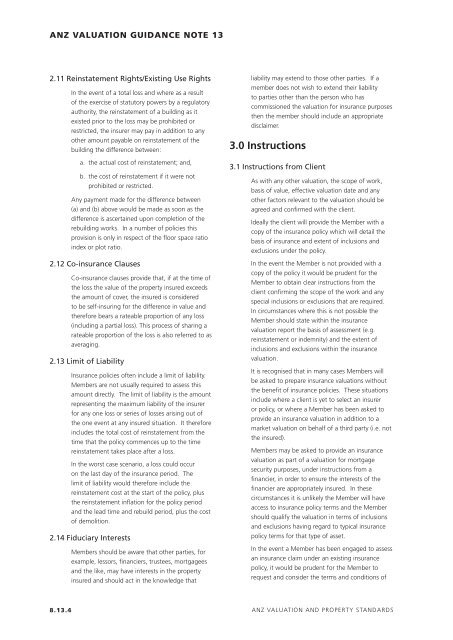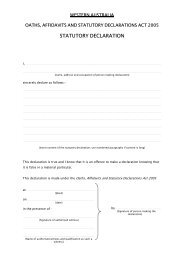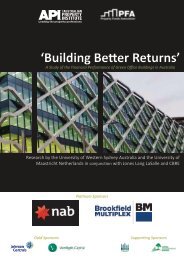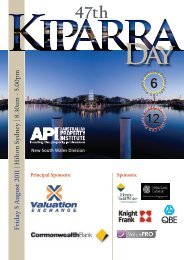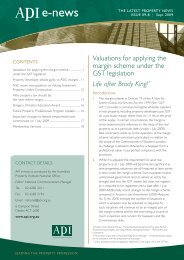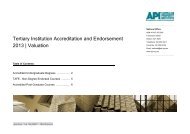VALUATIONS FOR INSURANCE PURPOSES
VALUATIONS FOR INSURANCE PURPOSES
VALUATIONS FOR INSURANCE PURPOSES
You also want an ePaper? Increase the reach of your titles
YUMPU automatically turns print PDFs into web optimized ePapers that Google loves.
ANZ VALUATION GUIDANCE NOTE 13<br />
2.11 Reinstatement Rights/Existing Use Rights<br />
In the event of a total loss and where as a result<br />
of the exercise of statutory powers by a regulatory<br />
authority, the reinstatement of a building as it<br />
existed prior to the loss may be prohibited or<br />
restricted, the insurer may pay in addition to any<br />
other amount payable on reinstatement of the<br />
building the difference between:<br />
a. the actual cost of reinstatement; and,<br />
b. the cost of reinstatement if it were not<br />
prohibited or restricted.<br />
Any payment made for the difference between<br />
(a) and (b) above would be made as soon as the<br />
difference is ascertained upon completion of the<br />
rebuilding works. In a number of policies this<br />
provision is only in respect of the floor space ratio<br />
index or plot ratio.<br />
2.12 Co-insurance Clauses<br />
Co-insurance clauses provide that, if at the time of<br />
the loss the value of the property insured exceeds<br />
the amount of cover, the insured is considered<br />
to be self-insuring for the difference in value and<br />
therefore bears a rateable proportion of any loss<br />
(including a partial loss). This process of sharing a<br />
rateable proportion of the loss is also referred to as<br />
averaging.<br />
2.13 Limit of Liability<br />
Insurance policies often include a limit of liability.<br />
Members are not usually required to assess this<br />
amount directly. The limit of liability is the amount<br />
representing the maximum liability of the insurer<br />
for any one loss or series of losses arising out of<br />
the one event at any insured situation. It therefore<br />
includes the total cost of reinstatement from the<br />
time that the policy commences up to the time<br />
reinstatement takes place after a loss.<br />
In the worst case scenario, a loss could occur<br />
on the last day of the insurance period. The<br />
limit of liability would therefore include the<br />
reinstatement cost at the start of the policy, plus<br />
the reinstatement inflation for the policy period<br />
and the lead time and rebuild period, plus the cost<br />
of demolition.<br />
2.14 Fiduciary Interests<br />
Members should be aware that other parties, for<br />
example, lessors, financiers, trustees, mortgagees<br />
and the like, may have interests in the property<br />
insured and should act in the knowledge that<br />
liability may extend to those other parties. If a<br />
member does not wish to extend their liability<br />
to parties other than the person who has<br />
commissioned the valuation for insurance purposes<br />
then the member should include an appropriate<br />
disclaimer.<br />
3.0 Instructions<br />
3.1 Instructions from Client<br />
As with any other valuation, the scope of work,<br />
basis of value, effective valuation date and any<br />
other factors relevant to the valuation should be<br />
agreed and confirmed with the client.<br />
Ideally the client will provide the Member with a<br />
copy of the insurance policy which will detail the<br />
basis of insurance and extent of inclusions and<br />
exclusions under the policy.<br />
In the event the Member is not provided with a<br />
copy of the policy it would be prudent for the<br />
Member to obtain clear instructions from the<br />
client confirming the scope of the work and any<br />
special inclusions or exclusions that are required.<br />
In circumstances where this is not possible the<br />
Member should state within the insurance<br />
valuation report the basis of assessment (e.g.<br />
reinstatement or indemnity) and the extent of<br />
inclusions and exclusions within the insurance<br />
valuation.<br />
It is recognised that in many cases Members will<br />
be asked to prepare insurance valuations without<br />
the benefit of insurance policies. These situations<br />
include where a client is yet to select an insurer<br />
or policy, or where a Member has been asked to<br />
provide an insurance valuation in addition to a<br />
market valuation on behalf of a third party (i.e. not<br />
the insured).<br />
Members may be asked to provide an insurance<br />
valuation as part of a valuation for mortgage<br />
security purposes, under instructions from a<br />
financier, in order to ensure the interests of the<br />
financier are appropriately insured. In these<br />
circumstances it is unlikely the Member will have<br />
access to insurance policy terms and the Member<br />
should qualify the valuation in terms of inclusions<br />
and exclusions having regard to typical insurance<br />
policy terms for that type of asset.<br />
In the event a Member has been engaged to assess<br />
an insurance claim under an existing insurance<br />
policy, it would be prudent for the Member to<br />
request and consider the terms and conditions of<br />
8.13.4<br />
ANZ VALUATION AND PROPERTY STANDARDS


